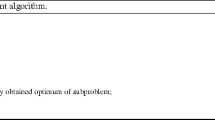Abstract
Support vector machines with ramp loss (\(L_r\)-SVM) have attracted considerable attention due to the robustness of the ramp loss. However, the corresponding optimization problem is non-convex, and the given Karush–Kuhn–Tucker (KKT) conditions are only first-order necessary conditions. To enrich the optimality theory of \(L_r\)-SVM, we first introduce and analyze the proximal operator for the ramp loss, and then establish a stronger optimality condition: P-stationarity, which is proved to be the first-order necessary and sufficient conditions for the local minimizer of \(L_r\)-SVM. Finally, we define the P-support vectors based on the P-stationary point and show that under mild conditions, all of the P-support vectors for \(L_r\)-SVM are on the two support hyperplanes.

Similar content being viewed by others
References
Bartlett, P.L., Mendelson, S.: Rademacher and gaussian complexities: risk bounds and structural results. J. Mach. Learn. Res. 3, 463–482 (2002)
Beck, A.: First-Order Methods in Optimization. SIAM Publisher, Philadelphia (2017)
Brooks, J.P.: Support vector machines with the ramp loss and the hard margin loss. Oper. Res. 59(2), 467–479 (2011)
Carrizosa, E., Martin-Barragan, B., Morales, D.R.: Binarized support vector machines. Informs J. Comput. 22(1), 154–167 (2010)
Carrizosa, E., Morales, D.R.: Supervised classification and mathematical optimization. Comput. Oper. Res. 40(1), 150–165 (2013)
Carrizosa, E., Nogales-Gmez, A., Romero, M.D.: Heuristic approaches for support vector machines with the ramp loss. Optim. Lett. 8(3), 1125–1135 (2014)
Collobert, R., Sinz, F., Weston, J., Bottou, L.: Trading convexity for scalability. In: Proceedings of the 23rd International Conference on Machine Learning, pp. 201–208 (2006)
Collobert, R., Sinz, F., Weston, J., Bottou, L.: Large scale transductive SVMs. J. Mach. Learn. Res. 7, 1687–1712 (2006)
Cortes, C., Vapnik, V.: Support vector networks. Mach. Learn. 20(3), 273–297 (1995)
Ertekin, S., Bottou, L., Giles, C.L.: Nonconvex online support vector machines. IEEE Trans. Pattern Anal. Mach. Intell. 33(2), 368–381 (2011)
Gaudioso, M., Gorgone, E., Hiriart-Urruty, J.B.: Feature selection in SVM via polyhedral k-norm. Optim. Lett. 14(1), 19–36 (2020)
Hess, E.J., Brooks, J.P.: The support vector machine and mixed integer linear programming: ramp loss SVM with \(L_1\)-norm regularization. In: Proceedings of the 14th Informs Computing Society Conference Richmond, pp. 226–235 (2015)
Horn, R.A., Johnson, C.R.: Matrix Analysis. Cambridge University Press, Cambridge (2013)
Khemchandani, R., Suresh, C.: Optimal kernel selection in twin support vector machines. Optim. Lett. 3(1), 77–88 (2009)
Montaes, D.C., Quiroz, A.J., Dulcerubio, M.D., Riascosvillegas, A.J.: Efficient nearest neighbors methods for support vector machines in high dimensional feature spaces. Optim. Lett. (2020). https://doi.org/10.1007/s11590-020-01616-w
Moreau, J.J.: Fonctions convexes duales et points proximaux dans un espace hilbertien. C.R.Acad.Sci.Paris. 255, 2897–2899 (1962)
Polyak, R., Ho, S.S., Griva, I.: Support vector machine via nonlinear rescaling method. Optim. Lett. 1(4), 367–378 (2007)
Rockafellar, R.T., Wets, R.J.: Variational analysis. Springer Science and Business Media (2009)
Shen, X.T., Tseng, G.C., Zhang, X.G., Wong, W.H.: On \(\psi \)-Learning. J. Am. Stat. Assoc. 98(1), 724–734 (2003)
Wang, X.M., Fan, N., Pardalos, P.M.: Stochastic subgradient descent method for large-scale robust chance-constrained support vector machines. Optim. Lett. 11(5), 1013–1024 (2017)
Wang, Z., Vucetic, S.: Fast online training of ramp loss support vector machines. In: Ninth IEEE International Conference on Data Mining, pp. 569–577 (2009)
Wu, Y., Liu, Y.: Robust truncated hinge loss support vector machines. J. Am. Stat. Assoc. 102, 974–983 (2007)
Xu, L., Crammer, K., Schuurmans, D.: Robust support vector machine training via convex outlier ablation. In: Proceedings of the 21st National Conference on Artificial Intelligence, pp. 536–542 (2006)
Acknowledgements
The authors would like to thank the associate editor and two anonymous referees for their constructive comments, which have significantly improved the quality of the paper. This work was supported by the National Natural Science Foundation of China (11971052, 11926348-9, 61866010, 11871183), and the Natural Science Foundation of Hainan Province (120RC449).
Author information
Authors and Affiliations
Corresponding author
Additional information
Publisher's Note
Springer Nature remains neutral with regard to jurisdictional claims in published maps and institutional affiliations.
Rights and permissions
About this article
Cite this article
Wang, H., Shao, Y. & Xiu, N. Proximal operator and optimality conditions for ramp loss SVM. Optim Lett 16, 999–1014 (2022). https://doi.org/10.1007/s11590-021-01756-7
Received:
Accepted:
Published:
Issue Date:
DOI: https://doi.org/10.1007/s11590-021-01756-7




